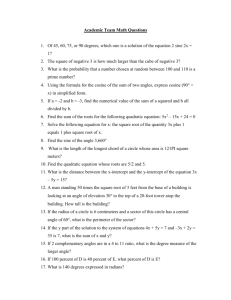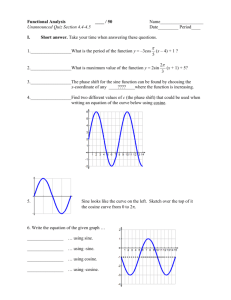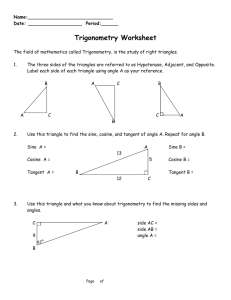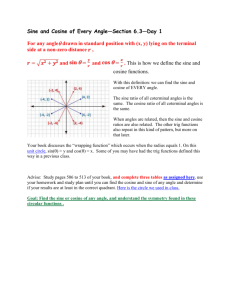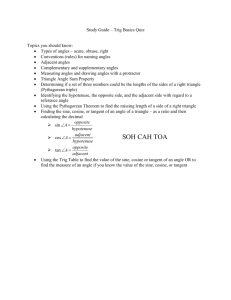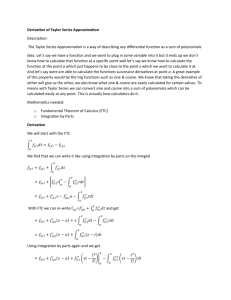Alberta7-10 webinar_April 16 2013_Marian
advertisement
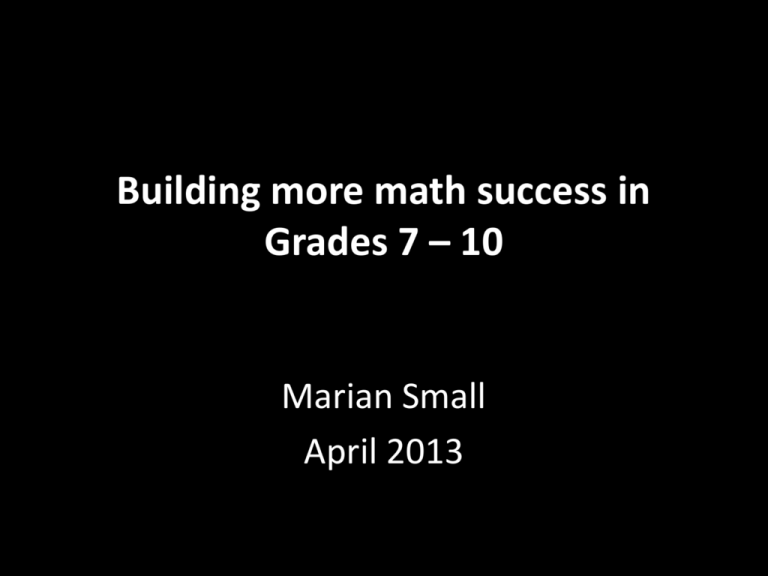
Building more math success in Grades 7 – 10 Marian Small April 2013 Focusing math instruction on what students need to know, not just what they can do The outcomes • , as they are presented in the curriculum document, speak more to what students need to do than what they need to know. For example, Grade 7 • Solve percent problems involving percents from 1% to 100%. So what do you think matters most? Poll: • A: Recognizing the three different types of percent problems and realizing what’s different about solving them • B: Being able to estimate the answer to a percent problem. • C: Recognizing the equivalent fractions and decimals for a percent. What do you think of this? • That students realize that every percent problem involves renaming a ratio in the form []/100 in another way. For example… • Why is finding the sale price actually renaming 40/100 as []/70? For example… • I paid $30 on sale. • What was the original price? • Why is renaming the original price really renaming 40/100 as 30/[]? For example… • I paid $30 instead of $80. • What was the percent paid? • Why is finding the percent paid really renaming 30/80 as []/100? Another important idea… • That students realize that knowing any percent of a number tells you about any other percent. For example… • I tell you that 20% of a certain number is 42. • What other percents of that number do you know even before you figure out the number? Write the percents you know • on the blank screen. If I tell you… • 15% of a number, how could you figure out 75% of that number? • Raise your hand to respond. If I tell you… • 15% of a number, how could you figure 5% of that number? • Raise your hand to respond. If I tell you… • 15% of a number, how could you figure out 50% of that number? • Raise your hand to respond. Another important idea • That renaming a percent as a fraction or decimal sometimes helps solve problems. For example… • I want to figure out how much I can withdraw from my bank account if Mom says 25% maximum. • I have $424. • How could I figure out the amount in my head? Which of these problems also makes the point? Poll • A: estimating 35% of 612 • B: calculating 10% of 417 • C: calculating 43% of 812 • D: two of the above Let’s look at Grade 8 • Model and solve problems concretely, pictorially and symbolically, using linear equations of the form: • ax=b • x/a = b,a≠0 • ax+b=c • x/a+b=c,a≠0 • a(x+b)=c where a, b and c are integers. What matters • besides just solving? I think that most important is… POLL: • A: Using more than one strategy. • B: solving symbolically • C: Estimating solutions • D: Checking that a solution is correct by substituting Maybe estimation • We want students to come up with a reasonable estimate for a solution without solving first. So I might ask… • Is the solution to 3x/4 – 12 = 6 closer to 0, 10, or 20? How do you know? So I might ask… OR • The solution to an equation is close to 40, but not exactly 40. What might the equation be? So I might ask… OR • How might I estimate the solution to 5x – 80 = 300 without actually solving it? So I might ask… OR • Can you estimate the solution to the equation 3x + [] = 90 by ignoring the [] and just saying 30? Another important idea • That the same equation could represent very different problems. So I might ask… • Write a real-life problem that might be solved using the equation x/4 – 12 = 10. • How are our problems alike? Different? • But let’s start with something just a tad simpler since we’re online. Which problem relates to x/4 – 12 = 10? POLL • A: There were 4 kids sharing a prize. They gave $12 away and there was $10 left. What was the amount of the prize? • B: 4 kids shared a prize. One kid gave $12 away and still had $10 left. What was the amount of the prize? • C: 4 kids shared a prize. One kid gave $12 away and still had $10 left. What was each kid’s share? Or… • Represent each problem on the next slide with an equation. What do you notice? Why does that make sense? Or… • Problem 1: The perimeter of a regular hexagon is 90 cm. What is each side length? • Problem 2: A rectangle’s length is twice its width. The total perimeter is 90 cm. What is the width? • Write your response on the whiteboard or raise your hand. Problem 1: The perimeter of a regular hexagon is 90 cm. What is each side length? Problem 2: A rectangle’s length is twice its width. The total perimeter is 90 cm. What is the width? And the flip side… • You can always represent a problem with an equation in more than one way. For example… • Write an equation to represent this problem : Jennifer had twice as many apps as Lia. Together, they had 78 apps. How many did each have? • What other equation could you have written instead? • Write one equation on the whiteboard. Or… • A problem is represented by the equation 2x + 18 = 54. • What could the problem have been? • What other equation could have represented the problem? • Which equation do you like better? Why? Another important point • That modelling an equation to help you solve it always involves some sort of “balance”. For example…. • Where are the 3, the multiplication inside of 3x, the x, the 5, the 26 and the = in the picture below that represents the equation 3x + 5 = 26? X X X 26 5 • You raise your hand about where you see the 3 and the multiplication. Or… • Some people say that an equation (e.g. 4x – 5 = 19) describes a balance. What do they mean? Or… • How could you use a pan balance to model the equation 3x + 8 = 29? • Why does the model make sense? Another important point… • Solving an equation means writing an equivalent equation that is easier to interpret. (e.g. We rewrite 3x – 8 = 19 as 3x = 27 or x = 9 since they say the same thing but it’s quicker to see what x is.) So we might ask… • Why might it be useful to rewrite the equation 4x + 18 = 66 as 4x = 48 in order to solve it? • Why are you allowed to do that? Or we could ask… • Why might someone call the equations 3x – 5 = 52 and 3x = 57 equivalent? • Which would you rather solve? Why? Do we have • Grade 10 teachers on line? • If so, we will continue with the presentation. • If not, we will engage in a conversation about how to do this work with other expectations. Grade 10 • Develop and apply the primary trigonometric ratios (sine, cosine, tangent) to solve problems that involve right triangles. Of course… • Students need to learn the definitions of sine, cosine, tangent. These matter, but they are not ideas. • But what ideas do they need to learn? What do you think is important? • POLL: • A: to predict whether sine, cosine or tangent is greater for particular angles • B: to learn that sin2 + cos2 = 1 • C: to learn that the size of sine or cosine is independent of triangle size Maybe… • The size of the trig function has nothing to do with the size of the triangle, i.e. a big triangle and little triangle can have the same sine, cosine and/or tangent. So you might ask… • The sine of an angle in a right triangle is 0.42. • Is it more likely that the hypotenuse is 1 cm, 10 cm or 100 cm, or don’t you know? Explain. You might want them to know.. • That a bigger angle (in a 90° triangle) has a bigger sine and a smaller cosine and why, but that the change in angle size is not proportional to the change in sine or cosine. So you might ask… • The sine of <A is 0.2 greater than the sine of <B. • Do you know which angle is greater? Explain. • Do you know how much greater the bigger angle is? Explain. You might want students to realize… • That even though sines and cosines have to stay 1 or less, tangents can get really big and why. So you might ask…. • • • • Which statements below are true? Explain. The sine of an angle can never be 2. The tangent of a small angle can be 2. The tangent of a large angle can be 5. There is no greatest possible tangent. You might want students to… • Have a sense of trig ratio relationships, e.g. when sine > cosine, that tan > sine, etc. So you might ask… Consider each statement. The angles are all less than 90°. Is the statement always, sometimes or never true? Use the pen tool to write a check or x to indicate your thoughts. • • • • • sin A > sin B when A < B cos A > cos B when A < B tan A > sin A cos A < tan A sin A = cos B To conclude • The work we are talking about involves looking deeply at outcomes to focus on the ideas that are critical to really understanding what is going on. To conclude • It is not about the complexity of questions students can answer. Download • Download these slides at • www.onetwoinfinity.ca (Alberta7-10 webinar) • ERLC wiki at http://goo.gl/LxO95
